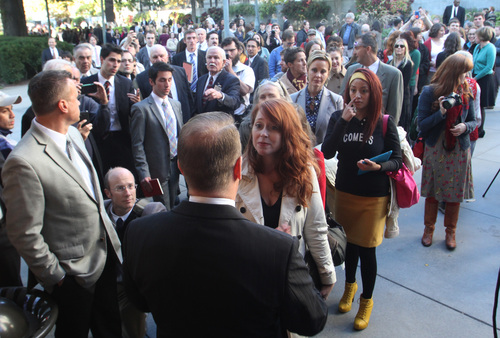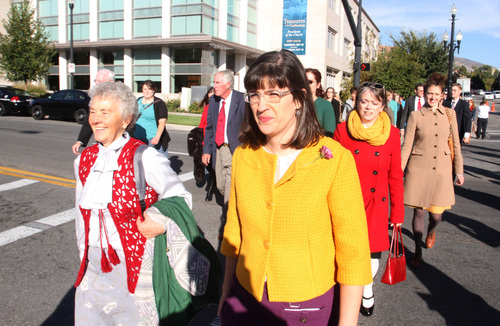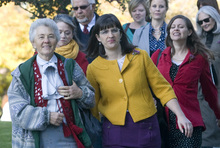This is an archived article that was published on sltrib.com in 2014, and information in the article may be outdated. It is provided only for personal research purposes and may not be reprinted.
Ordain Women has rolled out the next phase of its push for ordination to the all-male LDS priesthood — and it doesn't involve trooping to Temple Square.
But it does involve, in true Mormon fashion, attending meetings — either online or in person.
The group's debut tactic was to try to get in the males-only priesthood session of LDS General Conferences in October and again last month. On both occasions, hundreds of women, dressed in their Sunday best, walked en masse to downtown Salt Lake City's Mormon Tabernacle to request, one by one, standby tickets to show, organizers said, their readiness for the priesthood.
Both times, they were rebuffed — and they said they would not make a third attempt.
Clearly, these feminists have work to do persuading top LDS leaders to acknowledge their cause.
After meeting last week with several representatives of Mormon Women Stand, which supports the church's status quo, LDS public-relations officials had no intention of granting a similar audience with an Ordain Women delegation, according to spokesman Cody Craynor, calling it an activist group "whose demands are inconsistent with church teachings and doctrine."
So Ordain Women is striving instead to build grass-roots support within the 15 million-member Church of Jesus Christ of Latter-day Saints by creating small discussion groups to find more proponents among the vast majority of Mormons who say they are comfortable with the current gender roles and division of labor in the Utah-based faith.
The feminists have created "Six Discussions" — modeled after an earlier LDS missionary strategy for teaching potential converts — describing Mormon theology, scriptures, history and interpretations that provide context for potential ordination of women. They also spell out differences between how men and women are treated in the contemporary church and raise questions about those practices.
The first discussion topic is called "See the Symptoms" and includes an essay on patriarchy as well as a game of "Patriarchy Bingo." Its squares had statements such as these: "If you looked for spiritual guidance, it was usually from a man." "Most scripture stories were about men and their spiritual journeys." "The leaders whose names you memorized and whose words you read were men."
The packet also lists eye-popping statistics on men and women in LDS Church administration: There are 122 male general authorities, compared with nine female general auxiliary leaders. Since 1974, there have been 359 male speakers who gave 2,708 sermons at twice-yearly General Conferences, compared with 64 females who gave 269 talks.
Or how about this? The church's Handbook 1, which spells out instructions for its ecclesiastical leaders, is handed out to 118,000 men (general authorities, stake presidencies and bishoprics) and nine women (the general auxiliary leaders).
The Ordain Women materials are meant to spark fresh thinking among Latter-day Saints, says group founder Kate Kelly. "We are at a precipice of a conversation about ordination," Kelly says. "We want to bring that conversation to a wider audience, not just to people who already agree but to anyone with questions about gender and equality."
Kelly, a human-rights attorney in Washington, D.C., who helped produce the discussion materials posted on the group's website, hopes participants will grapple with Mormonism's scriptures and history and discover women's place in them.
The next step, says Kelly, a churchgoing Mormon, is to "visualize the future."
"We want to know what the future could look like," she says. "We want to be part of that future and to frame [divine] revelation as a participatory process."
To that end, organizers are staging online discussions of the six topics and urging supporters to create their own small groups in living rooms or on Google Hangout across the globe to debate the material.
That effort has already begun, Kelly reports. "We have heard from women all over who are inviting friends and neighbors."
Lisa Torcasso Downing, an LDS convert in Dallas who blogs at Life Outside the Book of Mormon Belt, organized one such online group across five time zones with participants who range from mainstream Mormons to moderate members to feminist believers.
The group's first meeting was "lively, intelligent, considerate and probing," Downing said. "We've all grown, but not all members have grown toward embracing the idea of female ordination."
For her part, Downing — author of young adult novels "Island of the Stone Boy" and "Get that Gold!" — sees female ordination as a "viable goal."
To argue against it as a possibility, Downing says, "demonstrates a lack of faith ... in modern revelation and the power of the priesthood to receive the word of God as direction for these latter days."
Still, Downing parts ways with Ordain Women organizers when they try to bring about change in the church through "faithful agitation," listed as an objective for the Six Discussions.
These feminists' "efforts to agitate are alienating mainstream LDS women who see them as demanding and attempting to unrighteously usurp power and authority," Downing says. "That estimation may be unfair, but it exists nonetheless."
In a lengthy blog post, titled "Kingdom of God and the Civil Disobedience Model," Downing argued that "you can't serve or help people who reject that service and help. ... If female ordination is to come, in whatever its form, it will come only when we mortals want the blessing. It seems counterintuitive to me that Heavenly Father would force a blessing when the majority of his followers are arguing that they don't need it."
Diane Tueller Pritchett, a music teacher and former LDS Relief Society president in the Boston area, sees similarities between Ordain Women discussion groups and those proposed in Sheryl Sandberg's best-selling book, "Lean In."
Pritchett, who spends part of the year in Utah, appreciates the topics and extensive research in the first discussion packet.
"It does confirm, however, that this is a political action activity," Pritchett says, " — organize, produce talking points, reach out to get others to join."
In the end, though, "I don't want the ordination of women to come via political action," she says. "I want it to come via revelation. I recognize that God can't reveal an answer to a question until we ask the question so I appreciate that there are people asking the question."
Mormons should be "talking and praying and asking and working together," Pritchett says. "The way I differ with [Ordain Women] is that we should also be waiting for answers. It is what we do while waiting that matters. Are we building Zion while waiting or hurting Zion?"
She says the question comes back to a stance she adopted years ago: "Be the change from within while waiting for God to speak."
"Be the change" is, in fact, Ordain Women's final discussion topic.
The group's founder acknowledges that the language of social activism is unfamiliar to most Mormon women, but she believes it is useful to borrow vocabulary and tactics from activist efforts.
"Part of what we are doing is new in every conceivable way," Kelly says, "For women to take direct action and communicate their message with their bodies and showing up in the tradition of social movements is 100 percent new."
It is, she says, "revolutionary."
And, Ordain Women backers hope, revelatory — since all they're asking is for the LDS prophet to inquire of the Lord.
Of course, they want God's answer to be yes.
Twitter: @religiongal —
Ordain Women's 'Six Discussions'
This series will feature one discussion each Thursday for the next six weeks, led by Ordain Women organizers and conducted via Google Hangout (with live-streaming through http://ordainwomen.org and from Ordain Women's YouTube channel at bit.ly/1opIxz6):
Discussion One — See the Symptoms
Was live on May 22 (recorded video is available on YouTube)
Covering the concept of institutional patriarchy and how it affects women and men unequally.
Discussion Two — Know The History
May 29 at 7 p.m. MDT
Covering the history of Mormon priesthood ordination.
Discussion Three — Study the Scriptures
June 5 at 7 p.m. MDT
Exploring the theological underpinnings of priesthood and ordination.
Discussion Four — Revel in Revelation
June 12 at 7 p.m. MDT
Examining how revelation operates within the LDS faith.
Discussion Five — Visualize Our Potential
June 19 at 7 p.m. MDT
Encouraging supporters to imagine the day women will be ordained and the blessings that could follow.
Discussion Six — Be the Change
June 26 at 7 p.m. MDT
Source: Ordain Women —
Ordain Women's discussion objectives
• To foster conversations that help people reflect on their own thoughts and experiences.
• To reaffirm our faith in God and testimony of continuing revelation.
• To encourage continued membership and full fellowship in the LDS Church as we explore the topic of women's ordination.
• To effect change through faithful agitation as a united group of LDS women.
Source: Ordain Women









